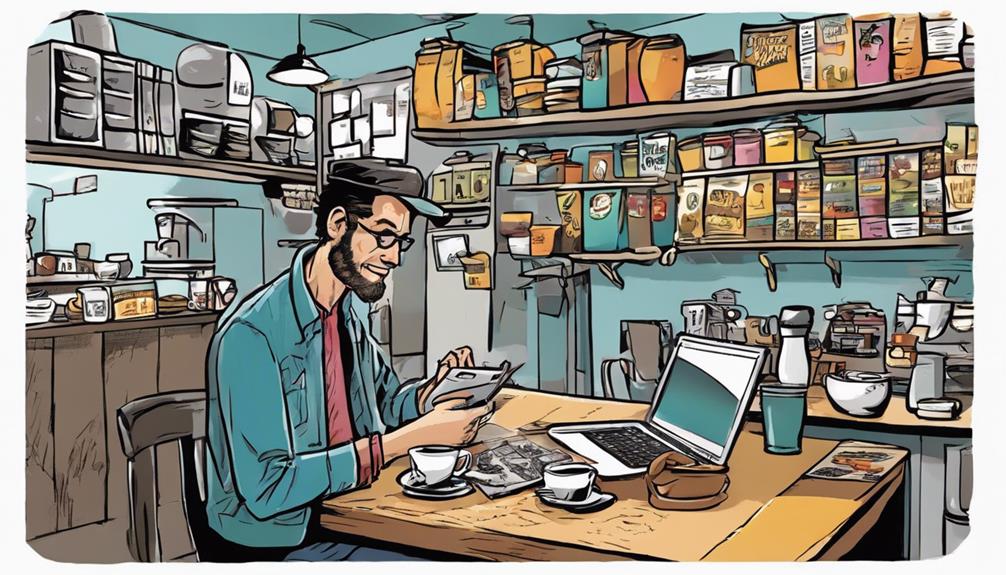Building a coffee trailer for your mobile cafe is a smart choice for maximizing profits. Lowering operating costs, flexibility in location, and potential annual earnings of $50,000 to $250,000 make it a lucrative venture. Ensure proper sanitation, reliable point of sale systems, and knowledge of different coffee types. Partner with wholesale roasters and bakeries to offer a diverse menu. Obtain necessary licenses and permits to comply with regulations. Market your brand through social media and partnerships. These are the key elements needed to create a successful coffee trailer business! Additionally, establishing a sound financial plan for your mobile cafe is essential for its sustainability. This includes budgeting for equipment maintenance, restocking inventory, and marketing costs. It’s important to monitor your income and expenses to maintain a steady cash flow and profitability. By effectively managing your finances, you can secure the long-term success of your coffee trailer business.
Key Takeaways
- Choose a suitable trailer size and layout for efficient operations.
- Install necessary equipment like espresso machines, grinders, and refrigeration.
- Focus on quality materials for durability and aesthetic appeal.
- Design a functional and attractive interior for customer comfort.
- Ensure compliance with health and safety regulations in the build process.
Benefits of Coffee Trailer Business
Experience the numerous advantages of launching a coffee trailer business. Coffee trailers offer a profitable business opportunity with lower overhead costs compared to traditional brick-and-mortar cafes.
The flexibility in location, schedule, and service provided by mobile cafe establishments like coffee trailers allows for catering services at different events. With the potential to generate annual revenues ranging from $50,000 to $250,000, coffee trailers prove to be a lucrative venture.
The ability to relocate the business to various locations ensures that you can reach a broader customer base and adapt to different settings. Whether it's setting up at a local fair, farmer's market, or corporate event, the versatility of coffee trailers allows for a dynamic approach to serving customers.
Embrace the benefits of a coffee trailer business and explore the opportunities it presents in the world of mobile coffee businesses. A coffee trailer business offers flexibility and mobility, allowing entrepreneurs to set up shop at various events, markets, and locations. With the rising demand for quality coffee on-the-go, starting a coffee business with a trailer can be a lucrative venture. By taking advantage of this unique business model, you can reach a wide range of customers and maximize your earning potential. The freedom to move from one location to another also gives you the opportunity to test out different markets and see where your coffee business thrives the most. Additionally, a coffee trailer business allows for creativity and innovation in the creation of unique coffee business ideas. Whether it’s introducing seasonal coffee flavors, partnering with local vendors for specialty ingredients, or offering customizable options for customers, there are endless possibilities to differentiate your business and attract new customers. With a coffee trailer, you have the flexibility to adapt to changing trends and customer preferences, ensuring that your business remains relevant and successful in the competitive coffee industry.
Cost Analysis and Profit Potential

When contemplating starting a coffee trailer business, it's important to examine the cost breakdown, revenue forecast, and overall profitability.
Understanding these key points will help you make informed decisions and set realistic expectations for your venture.
Cost Breakdown
How can you accurately assess the cost breakdown and profit potential of your coffee trailer business?
When diving into the world of mobile coffee business, understanding the financial aspects is key to setting up a successful venture. Here's a breakdown to help you navigate the costs:
- Startup Costs: Consider the expenses involved in purchasing equipment, the type of truck, and any customization needed for your coffee trailer.
- Truck Type: The choice between a used truck or a custom-made one significantly impacts the initial investment, with prices ranging from $35,000 to $155,000.
- Budget: Developing a detailed budget and business plan is crucial for financial planning and ensuring you allocate funds wisely.
- Profit Potential: Analyze how much you can potentially earn by selling your coffee products and services, factoring in costs and pricing strategies.
- Financial Planning: Take the time to evaluate the cost breakdown against the profit potential to make informed decisions for your coffee trailer business's sustainability.
Revenue Forecast
To accurately assess the profit potential and cost breakdown of your coffee trailer business, explore the revenue forecast through a detailed analysis of operational expenses and potential earnings.
When considering revenue forecast, take into account factors such as equipment costs, marketing investments, and pricing strategies.
By understanding your operational expenses and estimating potential earnings, you can create a budgeting plan that guarantees long-term sustainability for your mobile cafe.
Effective budgeting is vital for maximizing profitability in the mobile cafe industry. It's crucial to analyze profit margins and optimize pricing strategies to increase revenue.
Mobile coffee businesses have the potential to generate annual revenues ranging from $50,000 to $250,000. Your profit potential will heavily depend on variables like your location, menu offerings, and the size of your customer base.
Profitability Analysis
Effective cost analysis and profit potential assessment are crucial for optimizing the financial sustainability of your mobile coffee business. To ensure profitability in your venture, consider the following key points:
- Equipment Selection: Choose high-quality, efficient equipment within your budget to maximize operational efficiency.
- Budget Planning: Carefully plan and allocate your budget to cover essential expenses like equipment, permits, and supplies.
- Revenue Projections: Develop realistic revenue projections based on market research and industry trends to gauge your profit potential accurately.
- Overhead Costs: Keep overhead costs in check by operating a mobile setup, reducing expenses compared to traditional brick-and-mortar establishments.
- Business Plan Development: Create a thorough business plan outlining your goals, target market, and strategies to achieve profitability in your mobile coffee business.
Preparing for Coffee Trailer Operations

Make sure you implement proper sanitization practices to safeguard food safety and cleanliness in your coffee trailer operations. Utilize a reliable point of sales system to efficiently process transactions and maintain accurate sales records.
By gaining valuable insights from sales reports, you can track performance, identify trends, and make informed business decisions to optimize your operations.
Develop effective strategies for managing long lines during peak hours to enhance the customer experience and guarantee smooth service.
Stay informed about different coffee bean varieties, origins, and roasting methods to diversify and elevate your coffee offerings, attracting more customers to your mobile cafe.
Prioritizing these aspects won't only guarantee the quality and safety of your products but also contribute to a positive customer experience, boosting the success of your coffee trailer business.
Supplier Sourcing and Vendor Management

Implement effective supplier sourcing and vendor management strategies to secure quality products and streamline operations for your coffee trailer business. When sourcing suppliers for your mobile cafe, consider partnering with nearby wholesale coffee roasters for fresh beans or explore roasting your own.
Collaborating with bakeries can add variety to your menu and attract more customers. Confirm vendors can supply pre-packaged goods to meet health regulations easily. Additionally, streamline your inventory by selecting suppliers for paper supplies, condiments, and syrups.
Remember, the vendors you choose greatly impact the quality of your products and ultimately influence customer satisfaction. Make wise decisions to set the stage for a successful mobile coffee venture.
- Partner with nearby wholesale coffee roasters for fresh beans.
- Collaborate with bakeries to diversify your menu.
- Confirm vendors can provide pre-packaged goods for compliance.
- Source suppliers for paper supplies, condiments, and syrups.
- Choose vendors carefully to enhance product quality and customer satisfaction.
Legal Compliance and Planning

You must secure all necessary licenses and permits, such as food service and health permits, to operate your coffee trailer legally.
Remember to obtain parking permits and understand location-specific requirements to comply with regulations effectively.
Collaborating with local authorities and adhering to zoning regulations will be essential for a smooth and successful operation.
Permits and Licenses
To legally operate your coffee trailer business, obtaining the necessary permits and licenses is vital for compliance with local regulations. Here are some key points to keep in mind:
- Obtain essential licenses, such as food service and health permits, for legal operation.
- Secure parking permits and verify specific requirements based on your location.
- Consult local authorities for accurate information on permits and regulations.
- Maintain compliance with zoning regulations and health department guidelines.
- Detailed documentation, fee payments, and collaboration with city departments are essential for obtaining permits.
Regulatory Compliance
Regularly collaborating with relevant city departments is important for ensuring legal compliance and effective planning when operating a coffee trailer business. This includes working closely with the health department to meet safety and health standards.
Obtaining permits for public vending spaces and adhering to zoning requirements are critical steps in regulatory compliance. Collaboration with the Department of Transportation is also necessary to guarantee the proper use of public spaces. Detailed documentation and fee payments are essential for maintaining a legal operation.
Street vending permits may involve navigating intricate application processes and site-specific regulations. Compliance with city departments, such as street use officers, is crucial for obtaining the necessary permits to operate your coffee trailer business smoothly.
Planning for Compliance
Securing the necessary licenses and permits is fundamental for guaranteeing legal compliance when planning to operate a coffee trailer business.
To plan for compliance effectively, consider the following:
- Obtain essential permits such as food service, health, and business permits to meet regulatory requirements.
- Guarantee compliance with local regulations by securing permits like parking permits.
- Collaborate with local authorities and departments to verify specific requirements and stay compliant with zoning regulations.
- Maintain detailed documentation and make necessary fee payments to facilitate the permitting process.
- Work closely with the health department and buildings department to ensure safety and health compliance for your mobile cafe.
Marketing Strategies for Success

Establishing a strong brand identity is essential for differentiating your coffee trailer business in a competitive market.
In today's digital age, leveraging social media and online marketing is vital to reach and engage your target audience effectively.
By building partnerships with local businesses, events, or communities, you can expand your customer base and increase visibility within the community.
Offering promotions, discounts, or loyalty programs can incentivize repeat business and attract new customers to your coffee trailer.
Creative and eye-catching signage on your trailer can grab attention and spark curiosity among passersby.
Engaging with customers through interactive experiences and personalized service can foster loyalty and positive word-of-mouth recommendations.
Frequently Asked Questions
Is a Coffee Trailer Profitable?
Yes, a coffee trailer can be profitable for you! With revenue projections ranging from $50,000 to $250,000 annually and lower operating costs than traditional coffee shops, a well-managed coffee trailer business offers significant profitability opportunities.
Can You Make a Lot of Money Owning a Coffee Shop?
You can make a lot of money owning a coffee shop. Factors such as location, pricing, costs, and customer base impact profitability. High revenue comes from coffee, food, and specialty drinks. Managing well and offering unique experiences are essential.
What Is a Mobile Coffee Business?
You ask about a mobile coffee business. Imagine a coffee haven on wheels, bringing caffeinated joy to diverse crowds. It's a flexible, cost-effective venture catering events, markets, and more. Start brewing success today!
What Is a Coffee Trailer?
A coffee trailer is a mobile cafe on wheels, perfect for serving coffee and related drinks. It offers flexibility in location, catering to different customers at events. It's a cost-effective alternative to cafes, with high profit potential.
Conclusion
To sum up, building a coffee trailer for your business offers flexibility, low start-up costs, and potential for high profits.
With careful planning and strategic marketing, you can brew up success on wheels.
So, grab the wheel and drive your coffee business towards a bright and caffeinated future!









